Abstract
In several experimental models, synthetic peptides were shown to activate efficiently cytotoxic T-lymphocyte (CTL) responses and therefore represent an attractive strategy to develop new vaccines. However, the mechanisms by which they induce CTL responses are not yet fully understood. Several studies using 15 16-mer peptides previously demonstrated that CD4 helper T cells are required to induce optimal CTL responses with synthetic peptides. However, recently it was suggested that shorter 8 12-mer peptides could have an increased in vivo immunogenicity. In the present study, we therefore investigated if such optimal-length peptides still require CD4+ T-cell help to activate CTL responses. To address this question three synthetic peptides containing different viral CTL epitopes were injected into mice depleted of CD4+ or CD8+ T cells using specific monoclonal antibodies or into mice genetically deficient in those T-cell populations. Our results clearly established that activation of CTL responses by those short optimal peptides does not require CD4+ T-cell help and therefore suggested that high-density binding of peptides to major histocompatibility complex class I molecules on the surface of antigen-presenting cells is required for direct activation of CD8+ T cells, independently of CD4+ T-cell help.
Full text
PDF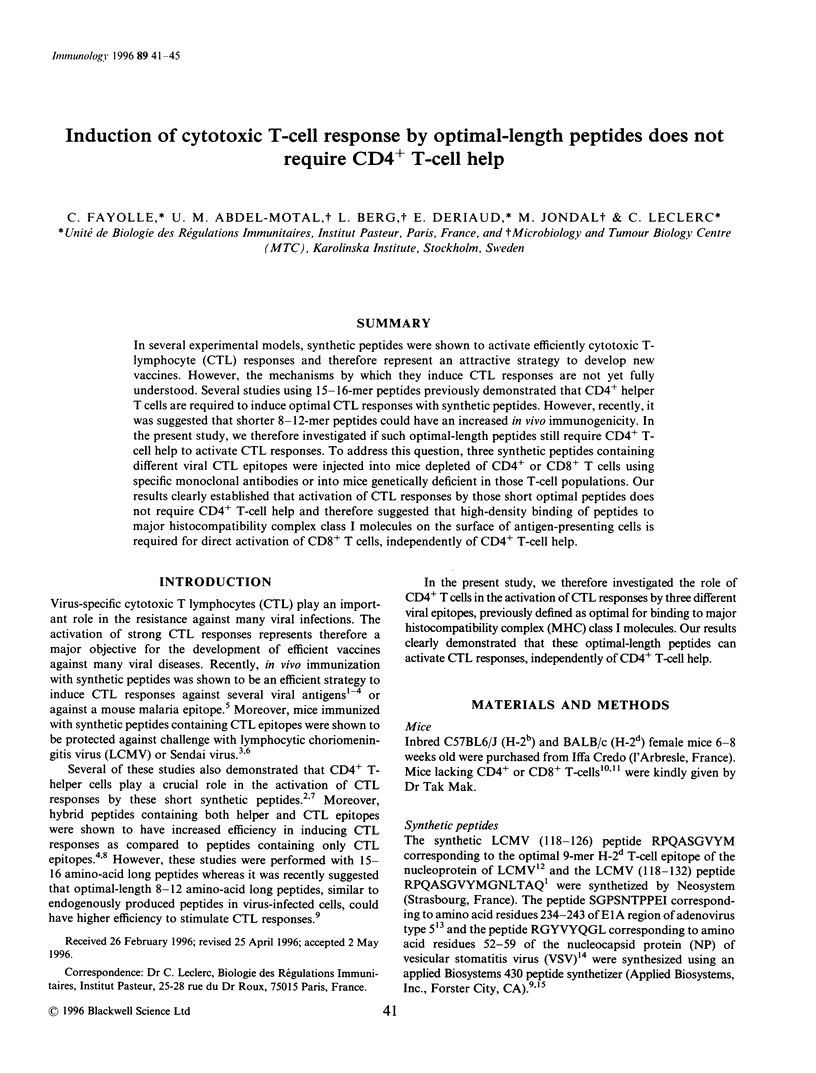
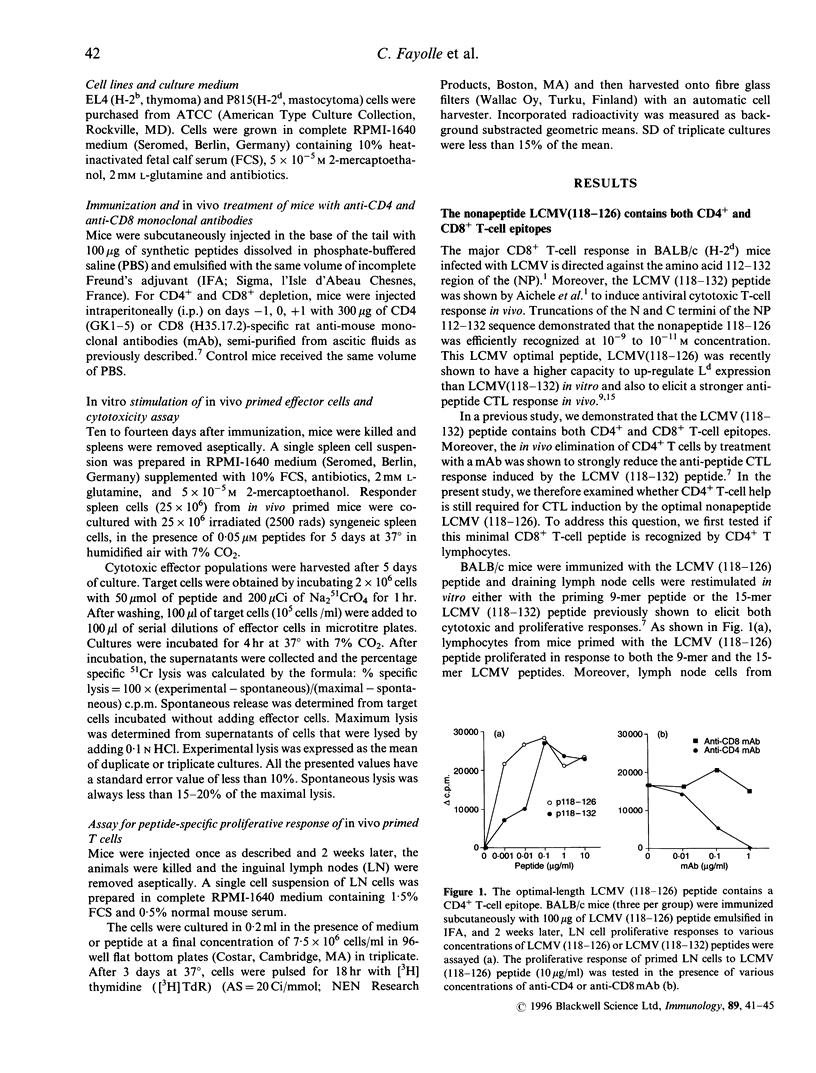
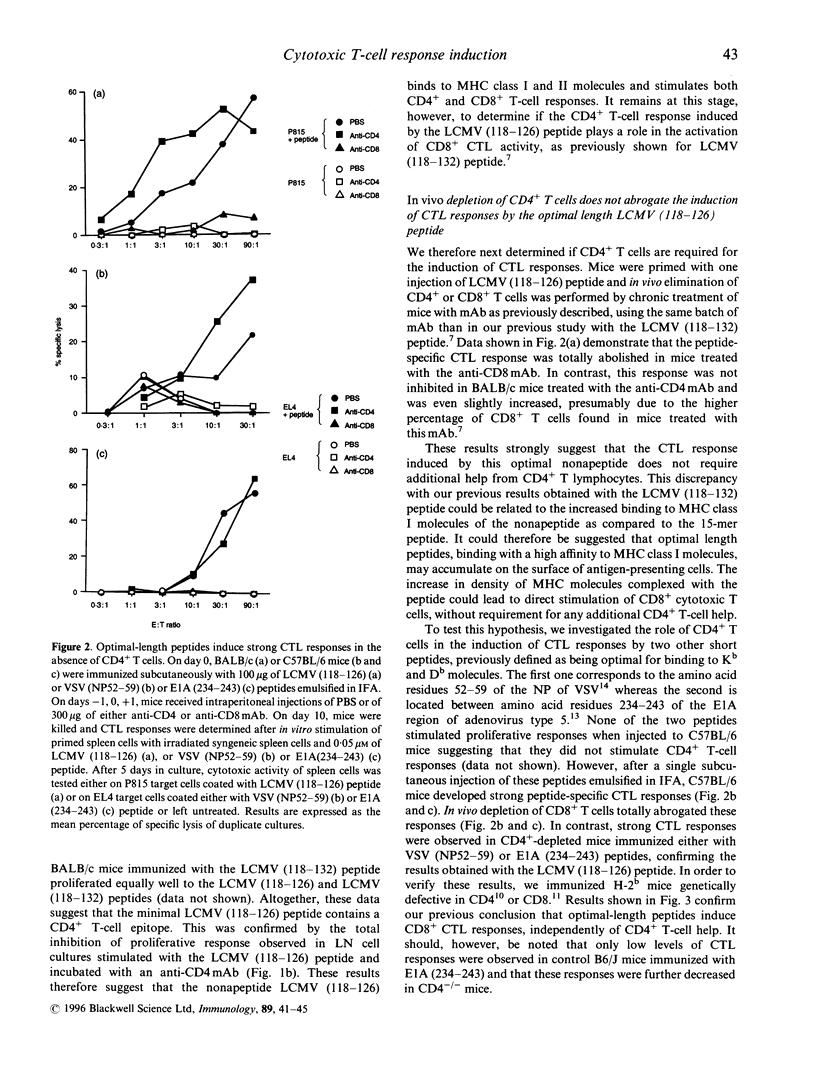
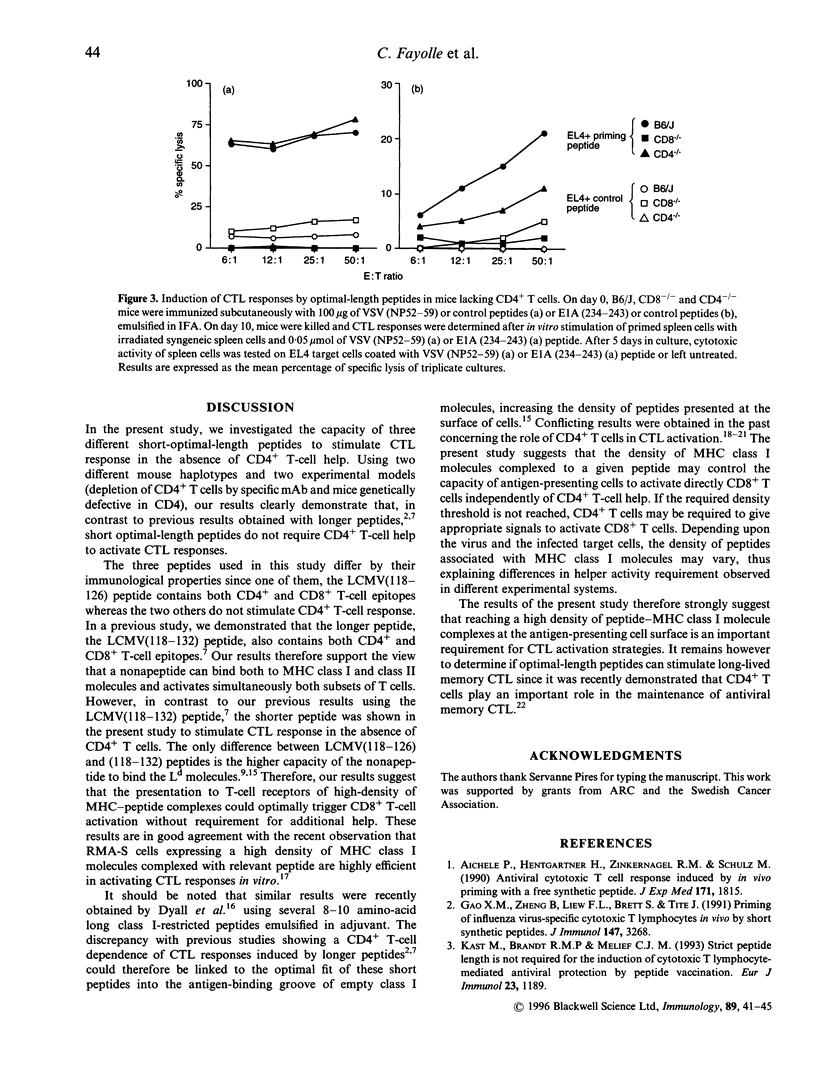
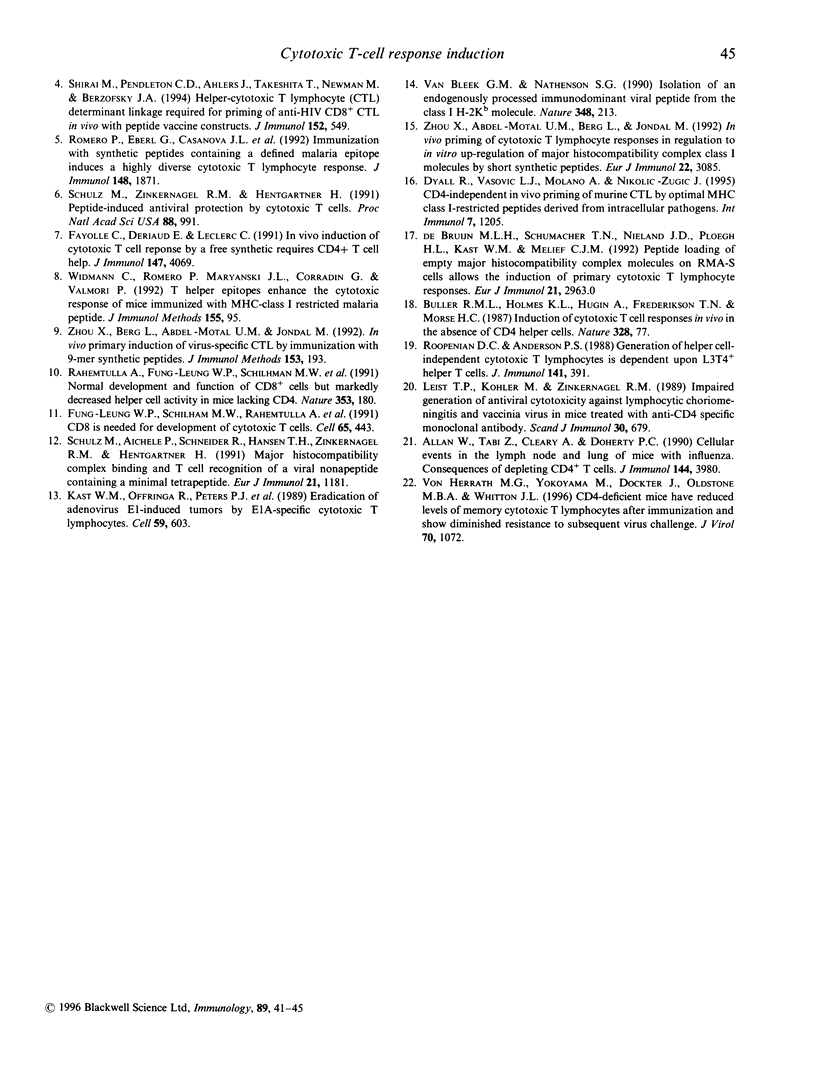
Selected References
These references are in PubMed. This may not be the complete list of references from this article.
- Aichele P., Hengartner H., Zinkernagel R. M., Schulz M. Antiviral cytotoxic T cell response induced by in vivo priming with a free synthetic peptide. J Exp Med. 1990 May 1;171(5):1815–1820. doi: 10.1084/jem.171.5.1815. [DOI] [PMC free article] [PubMed] [Google Scholar]
- Allan W., Tabi Z., Cleary A., Doherty P. C. Cellular events in the lymph node and lung of mice with influenza. Consequences of depleting CD4+ T cells. J Immunol. 1990 May 15;144(10):3980–3986. [PubMed] [Google Scholar]
- Buller R. M., Holmes K. L., Hügin A., Frederickson T. N., Morse H. C., 3rd Induction of cytotoxic T-cell responses in vivo in the absence of CD4 helper cells. Nature. 1987 Jul 2;328(6125):77–79. doi: 10.1038/328077a0. [DOI] [PubMed] [Google Scholar]
- De Bruijn M. L., Schumacher T. N., Nieland J. D., Ploegh H. L., Kast W. M., Melief C. J. Peptide loading of empty major histocompatibility complex molecules on RMA-S cells allows the induction of primary cytotoxic T lymphocyte responses. Eur J Immunol. 1991 Dec;21(12):2963–2970. doi: 10.1002/eji.1830211210. [DOI] [PubMed] [Google Scholar]
- Dyall R., Vasović L. V., Molano A., Nikolić-Zugić J. CD4-independent in vivo priming of murine CTL by optimal MHC class I-restricted peptides derived from intracellular pathogens. Int Immunol. 1995 Aug;7(8):1205–1212. doi: 10.1093/intimm/7.8.1205. [DOI] [PubMed] [Google Scholar]
- Fayolle C., Deriaud E., Leclerc C. In vivo induction of cytotoxic T cell response by a free synthetic peptide requires CD4+ T cell help. J Immunol. 1991 Dec 15;147(12):4069–4073. [PubMed] [Google Scholar]
- Fung-Leung W. P., Schilham M. W., Rahemtulla A., Kündig T. M., Vollenweider M., Potter J., van Ewijk W., Mak T. W. CD8 is needed for development of cytotoxic T cells but not helper T cells. Cell. 1991 May 3;65(3):443–449. doi: 10.1016/0092-8674(91)90462-8. [DOI] [PubMed] [Google Scholar]
- Gao X. M., Zheng B., Liew F. Y., Brett S., Tite J. Priming of influenza virus-specific cytotoxic T lymphocytes vivo by short synthetic peptides. J Immunol. 1991 Nov 15;147(10):3268–3273. [PubMed] [Google Scholar]
- Kast W. M., Brandt R. M., Melief C. J. Strict peptide length is not required for the induction of cytotoxic T lymphocyte-mediated antiviral protection by peptide vaccination. Eur J Immunol. 1993 May;23(5):1189–1192. doi: 10.1002/eji.1830230534. [DOI] [PubMed] [Google Scholar]
- Kast W. M., Offringa R., Peters P. J., Voordouw A. C., Meloen R. H., van der Eb A. J., Melief C. J. Eradication of adenovirus E1-induced tumors by E1A-specific cytotoxic T lymphocytes. Cell. 1989 Nov 17;59(4):603–614. doi: 10.1016/0092-8674(89)90006-8. [DOI] [PubMed] [Google Scholar]
- Leist T. P., Kohler M., Zinkernagel R. M. Impaired generation of anti-viral cytotoxicity against lymphocytic choriomeningitis and vaccinia virus in mice treated with CD4-specific monoclonal antibody. Scand J Immunol. 1989 Dec;30(6):679–686. doi: 10.1111/j.1365-3083.1989.tb02476.x. [DOI] [PubMed] [Google Scholar]
- Rahemtulla A., Fung-Leung W. P., Schilham M. W., Kündig T. M., Sambhara S. R., Narendran A., Arabian A., Wakeham A., Paige C. J., Zinkernagel R. M. Normal development and function of CD8+ cells but markedly decreased helper cell activity in mice lacking CD4. Nature. 1991 Sep 12;353(6340):180–184. doi: 10.1038/353180a0. [DOI] [PubMed] [Google Scholar]
- Romero P., Eberl G., Casanova J. L., Cordey A. S., Widmann C., Luescher I. F., Corradin G., Maryanski J. L. Immunization with synthetic peptides containing a defined malaria epitope induces a highly diverse cytotoxic T lymphocyte response. Evidence that two peptide residues are buried in the MHC molecule. J Immunol. 1992 Mar 15;148(6):1871–1878. [PubMed] [Google Scholar]
- Roopenian D. C., Anderson P. S. Generation of helper cell-independent cytotoxic T lymphocytes is dependent upon L3T4+ helper T cells. J Immunol. 1988 Jul 15;141(2):391–397. [PubMed] [Google Scholar]
- Schulz M., Aichele P., Schneider R., Hansen T. H., Zinkernagel R. M., Hengartner H. Major histocompatibility complex binding and T cell recognition of a viral nonapeptide containing a minimal tetrapeptide. Eur J Immunol. 1991 May;21(5):1181–1185. doi: 10.1002/eji.1830210513. [DOI] [PubMed] [Google Scholar]
- Schulz M., Zinkernagel R. M., Hengartner H. Peptide-induced antiviral protection by cytotoxic T cells. Proc Natl Acad Sci U S A. 1991 Feb 1;88(3):991–993. doi: 10.1073/pnas.88.3.991. [DOI] [PMC free article] [PubMed] [Google Scholar]
- Shirai M., Pendleton C. D., Ahlers J., Takeshita T., Newman M., Berzofsky J. A. Helper-cytotoxic T lymphocyte (CTL) determinant linkage required for priming of anti-HIV CD8+ CTL in vivo with peptide vaccine constructs. J Immunol. 1994 Jan 15;152(2):549–556. [PubMed] [Google Scholar]
- Van Bleek G. M., Nathenson S. G. Isolation of an endogenously processed immunodominant viral peptide from the class I H-2Kb molecule. Nature. 1990 Nov 15;348(6298):213–216. doi: 10.1038/348213a0. [DOI] [PubMed] [Google Scholar]
- Zhou X., Abdel Motal U. M., Berg L., Jondal M. In vivo priming of cytotoxic T lymphocyte responses in relation to in vitro up-regulation of major histocompatibility complex class I molecules by short synthetic peptides. Eur J Immunol. 1992 Dec;22(12):3085–3090. doi: 10.1002/eji.1830221209. [DOI] [PubMed] [Google Scholar]
- Zhou X., Berg L., Motal U. M., Jondal M. In vivo primary induction of virus-specific CTL by immunization with 9-mer synthetic peptides. J Immunol Methods. 1992 Aug 30;153(1-2):193–200. doi: 10.1016/0022-1759(92)90322-k. [DOI] [PubMed] [Google Scholar]
- von Herrath M. G., Yokoyama M., Dockter J., Oldstone M. B., Whitton J. L. CD4-deficient mice have reduced levels of memory cytotoxic T lymphocytes after immunization and show diminished resistance to subsequent virus challenge. J Virol. 1996 Feb;70(2):1072–1079. doi: 10.1128/jvi.70.2.1072-1079.1996. [DOI] [PMC free article] [PubMed] [Google Scholar]


